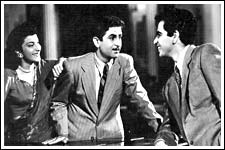
HOME | MOVIES | FEEDBACK |

Dinesh Raheja
With-it filmmakers like Yash Chopra and Karan Johar have, of late, explored the feasibility of purely platonic relationships between the sexes in such contemporary films as Dil To Pagal Hai (Shah Rukh Khan-Karisma Kapoor) and Kuch Kuch Hota Hai (Shah Rukh-Kajol).
Half a century ago, Mehboob Khan raised dust storms of debate with the same issue in his Andaz.
Andaz is also memorable because it was the only time that two legends, Raj Kapoor and Dilip Kumar, came together for a film, with fascinating results.
The object of Dilip and Raj's affection in the film is Nargis. Just 20 years old then, the poised, English-speaking Nargis perfectly suited the character of the immensely-wealthy, modern Nita who is at home in a world of butlers and mems (both are mentioned in the song O meri laadli which she sings in the film). Nita lives in a palatial house, wears monogrammed robes, goes riding in Jodhpurs and dances with men at her club.
Nita, however, is unspoilt. She develops a chatty friendship with Dilip (Dilip Kumar) and seems oblivious to his raging attraction towards her --- even when he croons such pointed songs as Tu kahe agar jeevan bhar main geet sunata jaoon.
Nita views Dilip as a platonic friend. Her heart belongs to Rajen (Raj Kapoor) who soon enters the picture after a sojourn abroad. Rich, outgoing, sartorially smart and in love, Rajen decides to marry Nina. Dilip is driven to confess his love for her on her wedding night. A distraught Nita goes on an extended honeymoon with Rajen.
But Rajen now reveals a dark undertone beneath his extroverted flippancy. His suspicions about her relationship with Dilip escalate and, in a pivotal scene, the two heroes repeatedly toss a symbolic flower towards each other.
A cataclysmic chain of events follow. When an injured Dilip lurches adamantly towards Nita, she shoots him down. She's brought to trial but Rajen refuses to come to her aid. Till it is too late.
The film could be read as a cautionary note for a newly independent India and the pitfalls of rampant Westernisation.
Paradoxically, Andaz, often cited as one of India's first modern films which captured the lifestyles of the creme de la creme; is also conservative in its portrayal of the disaster that can strike if women keep male friends. But director Mehboob Khan's vision is thankfully deep. The sympathy rests with the woman throughout. The two males come across as deluded fools or megalomaniac boors.
Mehboob also adeptly explores the varying aspects of love in this eternal triangle. In one scene, Dilip appears in Nita's
mirror as the manifestation of her subconscious, capturing the ambivalence of her feelings for him.
This landmark film on love, platonic and otherwise, is enhanced by its music and the stars. Dilip Kumar projects a seething intensity. Raj Kapoor and Nargis bring to vivid life the sheer ebullience of young love, especially in Yun toh aapas mein which Mehboob picturised in tight closeups of the two facing each other.
It's captivating to see three of the brightest names on the Hindi film firmament --- Nargis, Raj Kapoor and Dilip Kumar --- so
young and together onscreen for the first and last time. Any casting permutation combination with this trio is interesting;
to get them together is terrific.
Sidelights:
* Raj Kapoor tried to work a coup and cast Dilip Kumar and himself once again in Sangam (1964); but the stars had become bigger names then and it didn't work out.
* Andaz was Raj-Nargis' first major success together (their earlier release Aag had been accorded a lukewarm reception), and this seminal romantic pair went on to do 14 films together.
Nargis's niece Zaheeda says her aunt made the transition to mature, intelligent roles with Andaz: "It was a major hit followed by a line of superhits."
* In 1949 began the Raj-Dilip hegemony over filmdom. The same year, Dilip had another success in Shabnam, while Raj stormed the box office with Barsaat.
The Music:
* Music maestro Naushad made Mukesh sing for Dilip Kumar, while Mohammed Rafi playbacked for Raj Kapoor. Mukesh (who later went on to become Raj Kapoor's favourite playback singer), was used here to voice Dilip's anguish in Tu kahe agar, Jhoom jhoom ke naacho aaj, Toote na dil toote na and Hum aaj kahin dil kho baithe. Raj's solo song Yun toh aapas mein bigadte hai was vocalised by Rafi, who was later associated more with Dilip Kumar.
Despite the supersuccess of Andaz's songs, Mukesh's vocals were not used for Dilip again till almost a decade later with Yahudi and Madhumati (both 1958).
* Lata Mangeshkar benefited tremendously from Andaz. Naushad gave her career a tremendous boost by using her voice for heroine Nargis while leading playback singer of the day Shamshad Begum's vocals were used for danseuse Cuckoo in the duet Darna mohabbat karle.
* Naushad had to fight against several odds to justify his choice of Lata for the four female solos. He personally tutored the shy, skinny, young singer who was just starting out. On the day of the recording, he advised an apprehensive Lata to forget the presence of Mehboob Khan, Raj Kapoor and Dilip Kumar in the recording room and give her best. She did and got a standing ovation. Raj Kapoor decided to employ her voice for all the female songs of his forthcoming film Barsaat. After Andaz, Lata was on the road to superstardom.
You might also want to read:
|
||
© 1996 - 2002 rediff.com India Limited. All Rights Reserved. |
|||